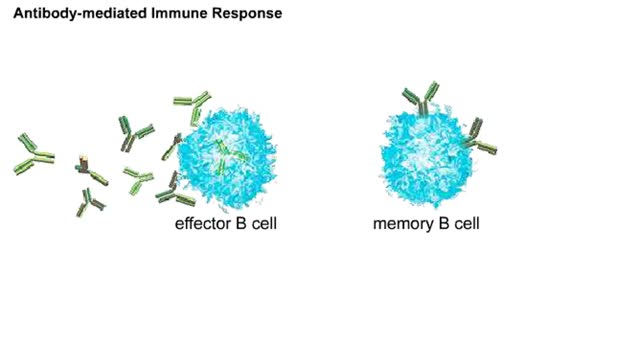Search Results
Results for: 'antigen'
Helper T cell receptors, activation, proliferation, differentiation & action
By: HWC, Views: 11902
• Most cells which have CD4 on their surface become Helper T cells (TN cells). • The CD4 1 cells only recognize a foreign antigen when it is presented with an antigen presenting immune cell (APC) that includes MHC-II protein. • The Helper T cell antigen receptor must match the presented...
Cell mediated immune response to a viral infection Animation
By: HWC, Views: 7578
Intracellular pathogens are the targets of cell-mediated immune response. The process begins when a virus infects a macrophage. Another macrophage engulfs the same virus or an antigen from it. In both cells, enzymes cleave the viral antigens into small bits. The fragments move to the cell sur...
By: HWC, Views: 12513
What Are Antibodies? Antibodies, also known as immunoglobulins, are Y-shaped proteins that are produced by the immune system to help stop intruders from harming the body. When an intruder enters the body, the immune system springs into action. These invaders, which are called antigens, can be vi...
Cytotoxic T cell receptors, activation, proliferation, differentiation & action
By: HWC, Views: 11956
• Most cells which have CD8 on their surface become cytotoxic T cells (Tc cells). • CD8 T cells recognize a foreign antigen when it is presented in conjunction with the protein, MHC-I. • Nearly all nucleated cells in the body express MHC-I molecules. • T cells that recognize self-pe...
By: HWC, Views: 8545
Overview of interactions in antibody-mediated and cell-mediated immunity Animation The antibody mediated immune response begins when a naive B cell encounters antigens from a pathogen, such as a bacterium. The B cell binds, processes, and displays this antigen. It is now an antigen-presenti...
By: HWC, Views: 11291
• T cells are responsible for cell-mediated immunity. • Each T cell contains a unique form of T cell receptor (TCR) on its membrane. • These T cell receptors are produced through a process of genetic recombination which is able to produce millions of different variations. • Each T ce...
Types of antimicrobial substances (interferons & complement protein)
By: HWC, Views: 11713
• Found in blood and interstitial fluids. • Discourage microbial growth. • Include interferon and complement proteins. • Produced and released by virus-infected lymphocytes. • Enter new cells and inhibit viral replication. • Act against a large variety of viruses (non-speci...
Types of disease resistance: innate defenses & immunity
By: HWC, Views: 11970
Our immune system protects us and helps fight off disease. Microorganisms, small microscopic organisms, and viruses are everywhere. Ever thought about how many are on that door you just opened? Many microbes and viruses can cause disease and are termed pathogens. Plants and animals have what i...
By: HWC, Views: 11411
• Non-specific and specific defense mechanisms work through the functions of complement proteins. • As soon as pathogens penetrate the physical barrier of the skin, other resistance mechanisms begin. • Cells, such as macrophages, phagocytize pathogens. • These cells increase exposu...
Advertisement











